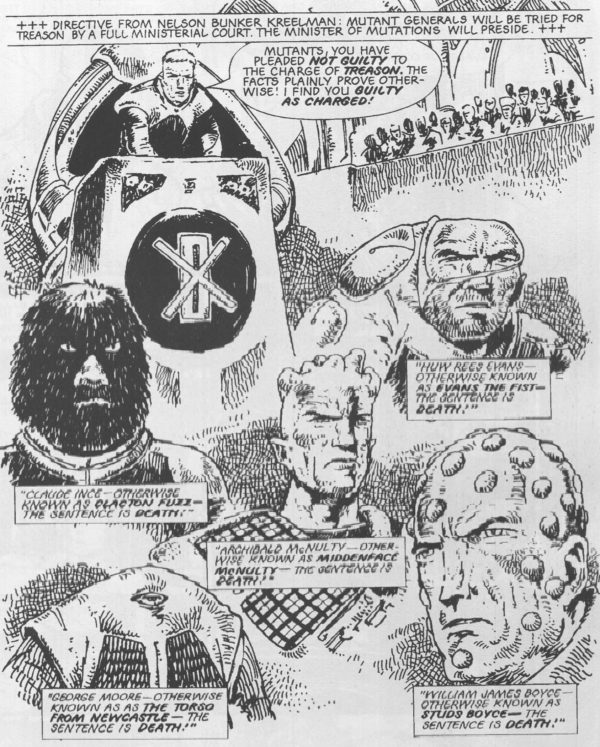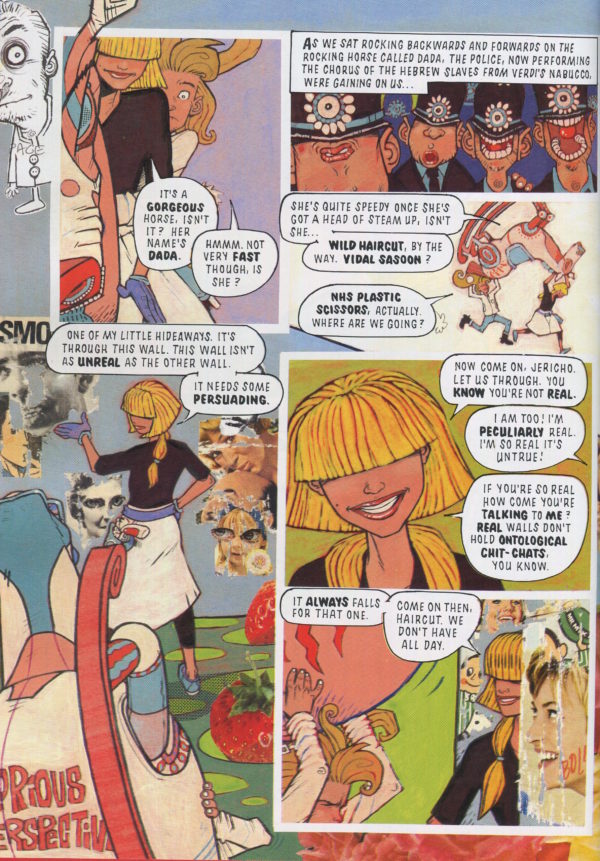
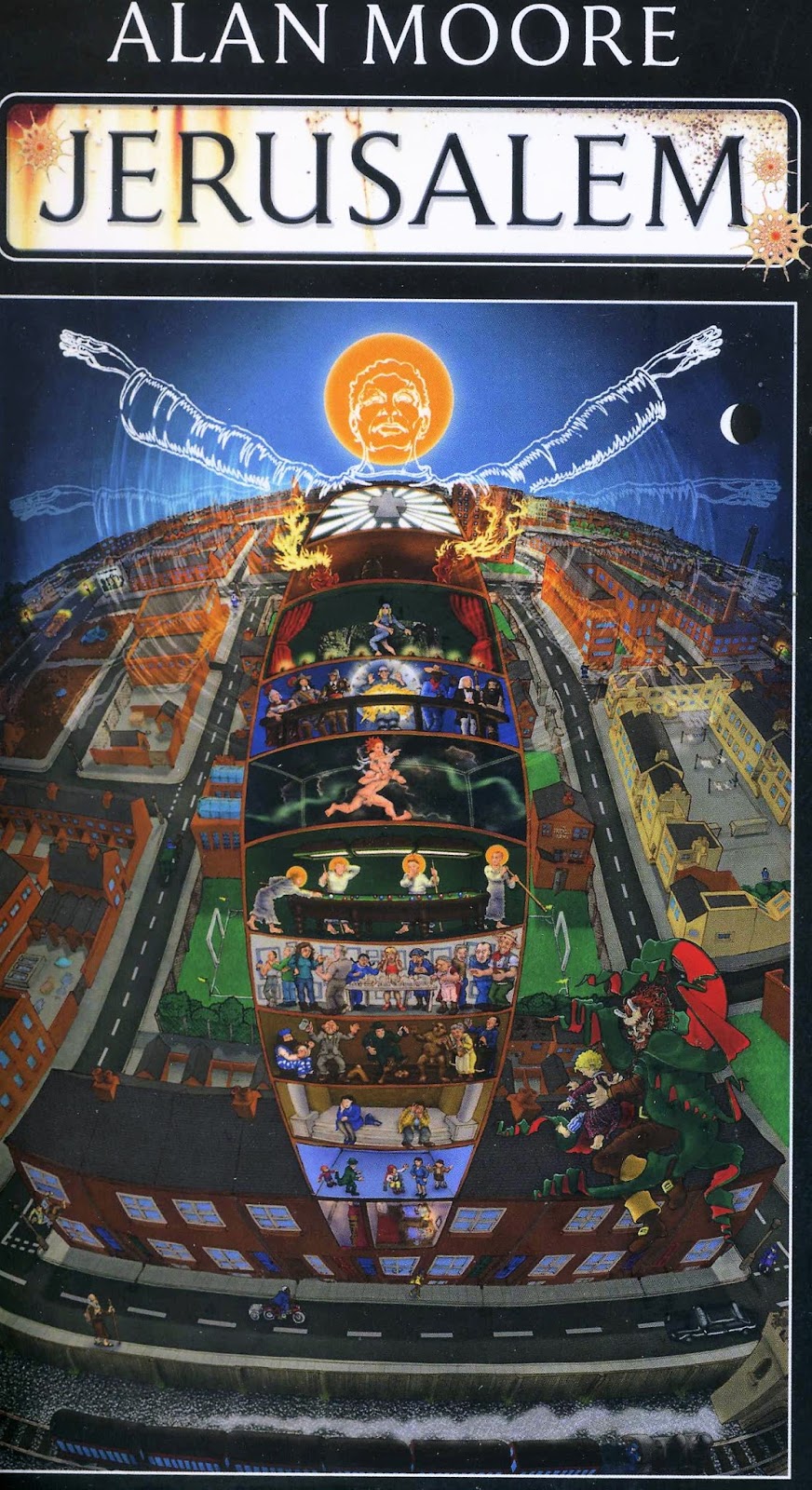 We’re back with another discussion of Alan Moore’s Jerusalem, this time dealing with “Rough Sleepers” up to “Atlantic.” Roughly, that’s pages 98-207.
We’re back with another discussion of Alan Moore’s Jerusalem, this time dealing with “Rough Sleepers” up to “Atlantic.” Roughly, that’s pages 98-207.
Josh: We open this section with Freddy, a character who, in many ways, exemplifies the class struggles that seem to exist for everyone in this novel. He moves about this worn-down city in his own worn-down way, finding meals and comfort wherever he can. He’s an interesting character to thread into our expanding cast, and one that echoes with the others already presented. There’s the plot element that recurs—the builders, but there’s also the way Freddy’s relationships with other people (I’m thinking of his entirely unsexy sex scene with Patsy) swirl around use and abuse of one another, the way people become handholds for one another to stay just above the crumbling foundations of their own lives.
Aaron: But he’s not above those foundations, right? Because Freddy and most of the people he interacts with are ghosts. With this chapter, Moore piles another genre into the book. And with it, he does to time what he’s been doing to space. For Freddy and his ghost friends, time exists all at once, piled together like muck; and interacting with it is, once again, a matter of perspective. And ghost drugs, I guess? Does it mean anything that, to interact with all of time, one has to be dead? Regardless, he’s the one whose feet we saw briefly in the previous chapter, sticking out from under a church gate in the “modern” world. But because he’s unstuck in time, he also meets the 9th century Brother Peter.
J: Yeah! Moore is doing some cool stuff, I think, with introducing or typifying different characters via different genres. It reminds me of China Mieville’s attempts to write a book in every genre, except Moore is doing it all inside his one gargantuan book! It’s cool, and speaking of genres, what about Brother Peter? There’s something here about Moore’s ability to tell about a place through vast stretches of history, but there’s also something here about the great power of Moore’s mythologizing. Here’s a character who has been through much, who’s looking for the mythical “centre,” and who moves through our narrative like a shaping, purposeful force. Yes, we know that something bigger is at stake in the narrative because of Alma’s art show, because of the Builders—but this brings home the point in a cool, unique way.
A: Between the Freddy and Peter chapters, we’re pretty sure that the Builders are archangels, right? Michael and Uriel, the boss angel and the angel of death, are named indirectly by Freddy. They’re the Builders represented by the cross and the skull. Any guesses on who the tower and dick angels are? There are traditionally seven archangels, but the only other two named (I think) are Raphael and Gabriel. Raphael is a healer, and Gabriel has a trumpet, right? And he spoke the Qur’an to Mohammed? Neither of those seems particularly dickish (unless we’re talking about Raphael the Ninja Turtle).
Or maybe they’re not angels. Maybe they’re something else, and we only think they’re angels because of the wing-like afterimages they leave as they move their arms through time.
Or does all this even matter?
J: Oh, definitely angels. They’ve gotta be angels: beings who have been working on the foundations of this place—apparently the center of space and time—since, well, forever apparently? Maybe it doesn’t matter, but I’m putting my money on angels.
How are you feeling about the nigh-encyclopedic style/approach now that we’re 200 pages in? Is it grating on you at all yet? For my part, I’m liking the book a lot, though each time we start a new chapter/character, I feel just the slightest bit of irritation. I want to trust Moore, and I do, but there’s a part of me that remembers the very opening of the book, the art exhibit that’s meant to frame this whole thing—and I wonder whether or not the continuous addition of characters and narrative lines and psychogeographical perspectives isn’t, in some ways, onanistic. In other words, stories are shaped things, right? The difference between a narrative and a dictionary is one is shaped by a beginning, a middle, and an end and the other attempts to tell everything about everything; one is curated and the other isn’t. Jerusalem was seriously hyped before publication, and Moore has done enough great stuff that he could publish his holiday card ideas as best sellers. And yet part of me wonders if I’m reading this very unshaped (at least thus far) thing and thinking, “wow, so good,” *because* it’s Alan Moore and I know he’s done great things so I must be not thinking hard enough/reading closely enough if I’m thinking some of this is unfiltered indulgence. I don’t know. What do you think?
A: For real thank you for defining “onanistic.” That’s one of the words (along with epistemological, logos, and many others) that just sit in a compost brain in my head, getting their juices all mixed together.
I actually really like the idea of a dictionary being a story, and I think a lot of decolonizing movements would say that some sense of story—some subjective life narrative—is implicit in the dictionary. Or in a textbook. But I don’t think that’s what you meant, so sorry for saying all that in bad faith.
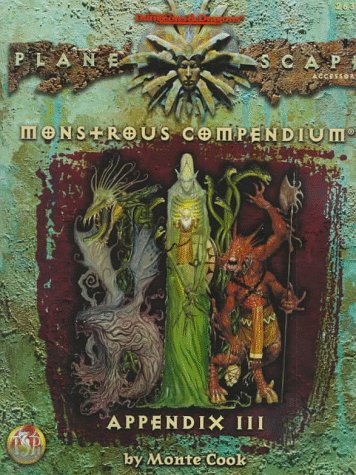 But I’m all for stories that don’t have shapes or have weird shapes. Don Quixote is a rambling mess with no sense of building action, but I love it. Pale Fire is basically an annotated poem with an index, and it’s riveting. But I also come from a background of reading RPG sourcebooks for fun. They’re hundreds of pages of gazetteer entries, monster stats, maps, and fictional histories, and I used to eat them up as a teen. It’s sort of an emergent storytelling approach? Maybe? Like, Jerusalem is to fiction what Legos are to toys. It’s a box of parts, and it’s up to us to make it “about” something. The chapters jump around, and in doing so, they set bounds for us to talk about perspective or religion or art.
But I’m all for stories that don’t have shapes or have weird shapes. Don Quixote is a rambling mess with no sense of building action, but I love it. Pale Fire is basically an annotated poem with an index, and it’s riveting. But I also come from a background of reading RPG sourcebooks for fun. They’re hundreds of pages of gazetteer entries, monster stats, maps, and fictional histories, and I used to eat them up as a teen. It’s sort of an emergent storytelling approach? Maybe? Like, Jerusalem is to fiction what Legos are to toys. It’s a box of parts, and it’s up to us to make it “about” something. The chapters jump around, and in doing so, they set bounds for us to talk about perspective or religion or art.
I’m feeling really hipster after writing all that, so I’m gonna go have a drink and play some video games.
J: I agree with everything you say here, and I’ve spent plenty of time enjoying strategy guides and reading through either dictionary-esque texts or just plain old dictionaries. And I like that sort of thing, but a novel still seems different to me. A dictionary is governed by the alphabet, right? And that’s it? It doesn’t privilege one letter over another, it doesn’t build toward anything, and entries are arbitrarily connected. Now sure, maybe you could come along and curate some cool story out of dictionary entries, but there’s no authorial will or effort behind arranging words/entries/etc in any sort of way: the alphabet decides it and that’s it. Pale Fire is incredible, I think, because it seems to be just an annotated poem but it reveals this dark, weird story behind it, the relationship between Shade and Kinbote, how it went wrong, what really happened, etc. That’s a narrative curated by Nabokov, and I’m not sure you get something like that from a dictionary (though I would love it if that existed!).
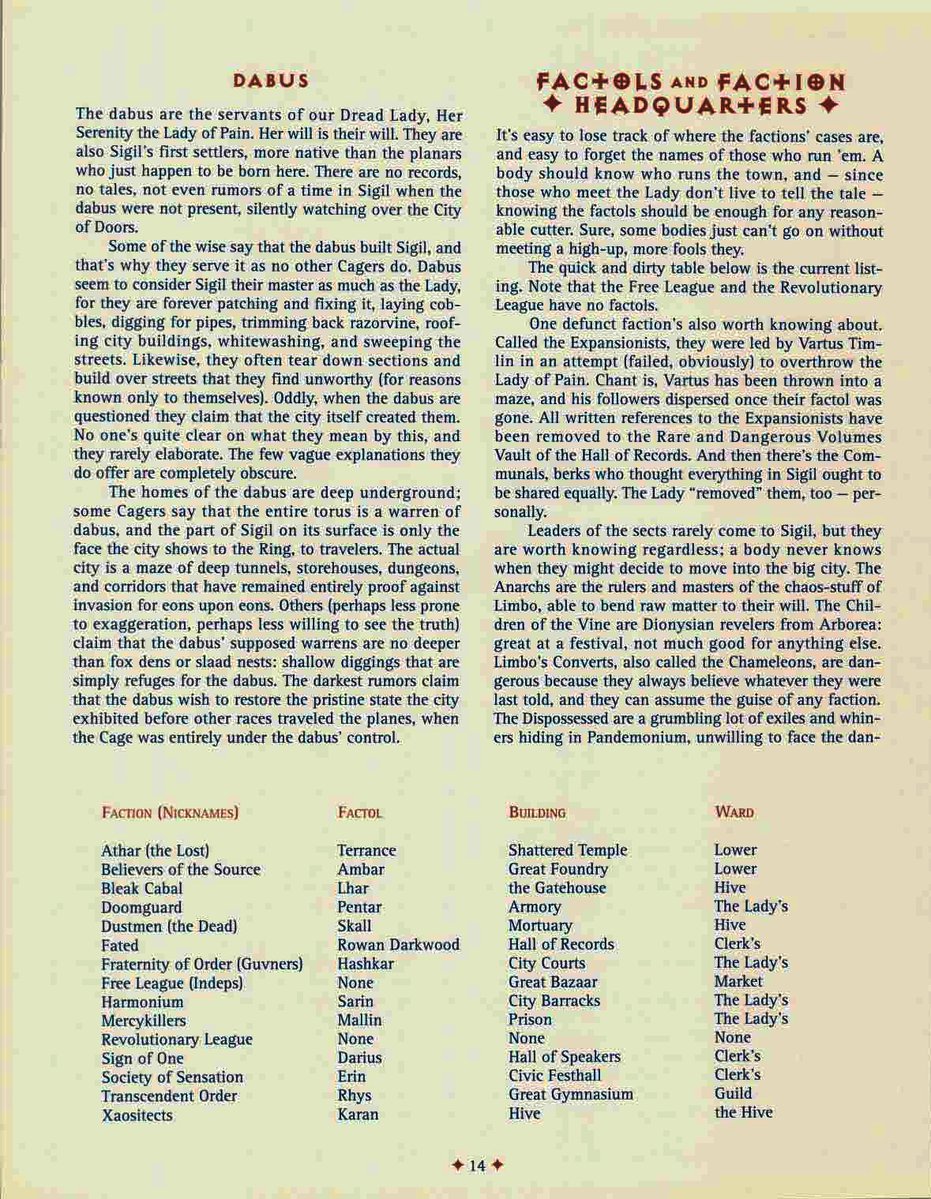
Anyway, I guess I’m just not yet sold (so it’s good we’re not done with the readthrough!) on everything Moore is giving us. If anything, it feels like he’s thrown out a whole bunch of raw material to the audience with a command of “build whatever you want with that,” which fits into your Legos idea. It’s weird and interesting and I don’t know if I like it yet!
I don’t have any video games to play, but I’ll take after you and have a drink.
Next month, we’re reading to “Hark! The Glad Sound!” Please join us!
Supplemental reading:
Don Quixote (1605) by Miguel de Cervantes
Pale Fire (1962) by Vladimir Nabokov
Advanced Dungeons & Dragons Planescape Campaign Setting (1994) by Zeb Cook, et al
China Mieville’s assorted works
What We’re Reading: Three Parts Dead

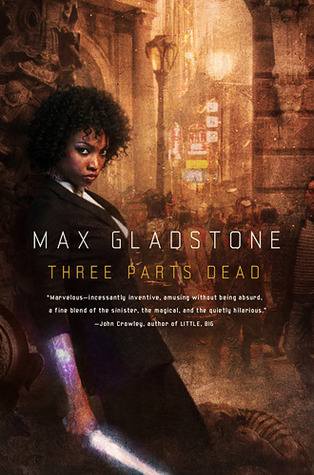 Three Parts Dead by Max Gladstone (Tor, 2012)
Three Parts Dead by Max Gladstone (Tor, 2012)
Max Gladstone’s debut novel Three Parts Dead doesn’t have a fantastic title. It sounds pulpy to the max (and this is coming from a great lover of pulp) with a dash of vagueness tossed in for good measure. It’s the kind of line someone on CSI: Arbitrary Metro Place might say while pulling down sunglasses. “I’d say this bartender is three parts—*tilts sunglasses*—dead.” And yet, the title is important. Gladstone wrote a nice post over at Tor describing why this and his other novels from the Craft sequence are named the way they are. And it turns a slightly cheeseball title into something charming and fun. Right? Right.
Three Parts Dead is more than anything else fun. I have final papers to grade and a new daughter missing several beats in her circadian rhythm and my own damn book to write and I just wanted something that would pull me in, make me excited to pick it back up, and reward me for investing in the story. And Gladstone’s debut novel does all of that and more.
The story is Tara Abernathy’s, a Craftswoman (a sort of magico-juridical necromancer person) who is thrown out of school, nearly killed, and then given a job working for a high-powered law firm. The case? Investigating the circumstances surrounding a god’s death and resurrecting Him if possible.
But this is also Abelard’s story, a young priest in the church of Kos the Everburning, the recently-dead god whose case (and resurrection) to Whom Tara is assigned.
And it’s also Cat’s story, a woman working as a peace officer (of a sort) and also in search of a high that will distract her from her life. Incidentally, her boss is the goddess Justice, who is a resurrected version of an old god named Seril. It’s complicated. Clearly.
Gladstone uses an omniscient third-person narrator to huge success in this novel, moving from character to character, following the story instead of perceptions of the story. The best moments in this book are when the same action is happening to/in front of/near many of the characters and the perspective moves effortlessly between them, keeping up the pace while adding in additional narrative stimulus. The climax of the story, which I won’t ruin and would probably take some serious time to explain anyway, is like this: strangely multi-perspectival and unified all at once. It’s great.
Three Parts Dead also has this great metaphor of the courtroom and legal troubles as fantastical and magical; it undergirds much of the action and plot in the story, and this way of jazzing up jurisprudence is hugely exciting and fun. About halfway through the novel, Tara and the opposing council present their opening arguments, but the whole thing takes the form of a magical contest held over the imagined (but very real) body of the dead god Kos. It does what fantasy is best at: taking a theoretical conflict and making it literal as a way of better exploring its nature. We see what legal battles are really about here: power, trickery, preparation, and will. It makes for a strangely exciting story about law.
If there are moment where Gladstone stumbles in this book, they are closely linked with how imaginatively his world has been built. Characters will sometimes turn to one another to explain things they both know (or should know) as a way to convey exposition or worldbuilding, and because the plot is tied up in the intricacies of a fantastical law system, Gladstone has to slam on the brakes at times to let us know what’s really going on, what’s really at stake, and what that person really said.
But those moments are few and easily forgotten in the greater genius of the novel. I can’t wait to dive in to the others.
What fun page turners have you been reading recently?
It can be a struggle to get foreign comics in America. While the manga boom proved that there was an audience for translated work, the publishers rarely looked past Japan—where manga was easy enough to format, what with it being the perfect size for mass consumption, other countries’ comics proved more of a challenge.
So comic stores are littered with failed imports. Full-sized French hardcovers failed; maybe it was the high price attached to lower-than-usual page counts. But on the other hand, chopping them down to something approaching manga size (as was done with Italian Hugo Pratt’s Corto Maltese) brings cries of bowdlerization.
Recently, I’ve gotten my hands on four collections of strips from Britain’s 2000 AD. 2000 AD is a sci-fi anthology comic that’s been released once a week since 1977, each issue containing a number of short chapters from ongoing stories. In America, the multi-artist anthology has been, for the most part, slowly dying since the ‘70s. Exceptions emerge, but as a viable format, especially on the level of 2000 AD, anthologies just don’t work in the US.
What follows, then, are looks at four different strips from 2000 AD collected in four different formats.
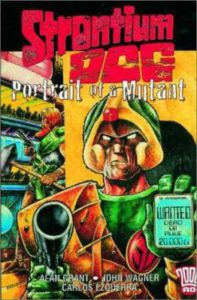 Strontium Dog: Portrait of a Mutant by Alan Grant, John Wagner & Carlos Ezquerra (2000 AD/Titan Books)
Strontium Dog: Portrait of a Mutant by Alan Grant, John Wagner & Carlos Ezquerra (2000 AD/Titan Books)
This is the earliest collection of the four—the stories were first printed in the early ‘80s, and the collected edition came out in 2002. (Funny story: when 2000 AD began, no one expected it to last as long as it did. Thus the “futuristic” name.)
This collection is also one of the largest, measuring 8 ¾” by 11 ¾”. It’s a softcover, and the covers sure don’t hold up well. It’s the kind of cover that curls and splits at the corners. Inside, the book collects two discrete storylines, the titular “Portrait of a Mutant” followed by “The Shicklgruber Grab.” This is not the original print order of the stories but is instead chronological order of the fiction.
Strontium Dog is the story of Johnny Alpha, a mutant bounty hunter with X-ray eyes. In his irradiated future, he takes jobs that humans find too dirty. “Portrait of a Mutant” details his origin in the wars for mutant rights. In “The Shicklgruber Grab,” Johnny travels back to Nazi Germany to kidnap Hitler and bring him to the future to stand trial.
The stories are fast-paced, full of dry humor and quick plot work. With just five pages per chapter, no one is allowed to stand still and emote unless it’s atop a flaming spaceship crashing to its doom. It reminds me of Fury Road: any sort of bloat has been edited out. The large size is perfect for Ezquerra’s scratchy inks and densely populated panels. His mutant designs are varied and unique, and he never repeats himself.
But where to after this? There’s no volume numbering anywhere in Portrait of a Mutant and no indication if another book is forthcoming. Is this the end of Johnny Alpha?!
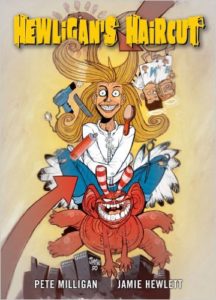 Hewligan’s Haircut by Peter Milligan & Jamie Hewlett (2000 AD)
Hewligan’s Haircut by Peter Milligan & Jamie Hewlett (2000 AD)
This collection only slightly edges Strontium Dog out in size, but only because it’s a hardcover. Collected in 2003, the story was originally printed in eight installments in 1990, making it the shortest collection.
The story sounds complicated: madman Hewligan is released from an asylum after giving himself a strange haircut, and he tours art-inspired parallel dimensions with his manic pixie dream girl, Scarlet. In the end, because this is 1990, Hewligan accepts and overcomes his madness with the power of love and the help of his quirky girlfriend. It’s vaguely insulting in the same way as the spate of MPDG films of the aughts (Elizabethtown, 500 Days of Summer)—madness is cute, and a man can only succeed in life with the help of a woman who does the emotional work for him.
The story has an odd pace, with Hewligan and Scarlet wandering through Dada, Pop Art, and beyond. Despite the same structure as Strontium Dog (multiple five-page chapters), it has none of the stakes. Someone is supposedly chasing the protagonists, but with a universe of cartoon escape routes, the tension never gets above a low simmer. But there is some good here! Hewlett, known for his design work with the Gorillaz, constructs a multimedia collage of dueling monochrome and saturation.
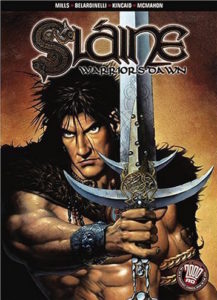 Sláine: Warrior’s Dawn by Pat Mills, Angeie Kincaid, Massimo Belardinelli & Mike McMahon (2000 AD/DC Comics)
Sláine: Warrior’s Dawn by Pat Mills, Angeie Kincaid, Massimo Belardinelli & Mike McMahon (2000 AD/DC Comics)
These stories originally appeared in 1983 and ’84 and were collected in 2005 as a part of a short-lived partnership with DC Comics (of Batman and Superman fame). Written by 2000 AD founder Pat Mills, Warrior’s Dawn follows Celtic barbarian Sláine (and sidekick Ukko) as they hew their way through a fantastical Bronze Age England.
Sláine’s world is strange and cruel. He fights time-displaced dinosaurs, rescues evil druidesses, and rides flying boats. And whenever things get rough, his body warps into a roiling, swelling thing that feels no pain. While some of the art is mediocre, looking posed and confusing, McMahon’s scratchy style is a perfect fit, and it thankfully fills most of the pages. Each of his panels feels like a dirt-smeared etching some archaeologist was lucky enough to dig up.
This collection, while not as large as the previous two, does at least indicate that it’s the first in many volumes, and it reprints the original stories in order. If only the partnership had lasted…
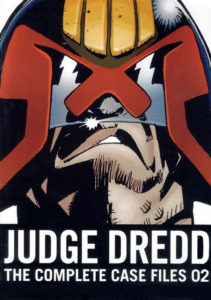 Judge Dredd: The Complete Case Files 02 by John Wagner, Pat Mills, Brian Bolland, et al
Judge Dredd: The Complete Case Files 02 by John Wagner, Pat Mills, Brian Bolland, et al
This is the beefiest collection of them all. While the pages aren’t numbered (why not?!), this book is at least three times as long as the others. With comics that have been around as long as 2000 AD, this approach makes the most sense to me: hundreds of pages in chronological order in clearly numbered volumes.
Except four chapters are missing due to lawsuit. The missing chapters took aim at some lovable fast food mascots, and the original publisher settled out of court.
Anyway, the stories are similar to Strontium Dog: fast-paced postapocalyptic romps that only pause to tell dark jokes and survey the carnage. Dredd and his fellow judges are fascists working for a literal police state, but the forces they fight are worse, so readers can root for them even if they can’t excuse them. The art is much more consistent than in Sláine; Mike McMahon makes another appearance here, adopting a much slicker style for the brutalist-futuristic look of Dredd’s Mega City.
There we have it, readers. Apologies if this was more of a review of formats than a review of content. Do the same concerns every apply to text-only books? Have you ever found the format of a book to affect your reading of it?
What We’re Reading: The Vanishing Kind

 The Vanishing Kind by Lavie Tidhar (The Magazine of Fantasy and Science Fiction, July/Aug 2016)
The Vanishing Kind by Lavie Tidhar (The Magazine of Fantasy and Science Fiction, July/Aug 2016)
The Vanishing Kind, Lavie Tidhar’s noir novella recently featured in The Magazine of Fantasy and Science Fiction, is the story of Gunther Sloam, a third-rate filmmaker from Berlin, who is searching post-WW2 London for a past love named Ulla Blau. The frame character through whose voice we get the story is Tom Everly of the Gestapo (at least, that’s who he says he is), and Tom (and/or his men) follow Sloam on the filmmakers London investigations. In this world, the Germans won the war (though there are small mentions of continued but futile resistance happening in America) and London is a city in need of rebuilding. It’s streets are filled with refuse, it’s buildings are in shambles from the war, and it’s people lead lives in the dark—trading illicit goods, working as prostitutes, hiding their identities. This is the London Sloam walks through, and no one here is as they seem: a rare book dealer is both a Jewish man living another identity and a drug circulator using the rare books as a front. A dwarf, wealthier than seemingly anyone else in London, meets Sloam in an abandoned church and reveals that he’s been paying for the German occupation, because “even Nazis need money.”
And yet the strangeness of “The Vanishing Kind” is not in the double lives and secret machinations of its characters—it is in semi-surreal movie logic that runs through this piece like a set of train tracks, guiding the narrative and reader alike. We are introduced to Sloam as a filmmaker, and many of his thoughts are through the lens of film (London is shows as a “city projected like the flickering images of a black and white film”), but the story itself—the characters, the odd coincidences, the villain’s speech and the hero’s resilience, the tidiness of the narrative, the sense that everyone here knows everyone else and the hero is slowly and inevitably nearing the final reveal—all of this is done with a tongue-in-cheek, meta-recognition of its own tropiness (Tidhar has never been shy about Phillip K. Dick’s influence on his work). Sloam should never survive even a few pages of this story, and yet he does, and his response each time is to wonder without purchase or understanding why in the world no one has shot him yet. He’s a man who has been forced to make pulpy films currently living in one of his own, and the illogical logic of these stories pushes him along from inevitable realization to inescapable meeting with little care for his awareness or comprehension. Here, for instance, is Tom Everly, the narrator, describing Sloam:
Of course the obstinate German did not take my advice. I had accused him of being a romantic and I wasn’t wrong. Gunther, for all his battle experience in the Wehrmacht, still insisted, deep down, to think of himself as a character in one of his own cowboy pictures. All he could think about was Ulla Blau’s ruined, once-beautiful face staring back at him from the mortuary slab. I think he believed himself untouchable. Most Germans did, after the war.
In this way, the novella leans on its author’s ethos to pull a reader along—knowing that Tidhar does these types of pastiche, send-up, derivation-with-a-meta-twist stories so, so well is enough to convince a reader during the early stages of the story that what seem to be heavy-handed, overly melodramatic moments in the text (or moments of serious and seriously questionable plot convenience) are in fact intentional—they are Tidhar’s attempts to build the pulp framework in which he is trying to find a story with unironic and genuine heart. And in this he succeeds. The plot ends with Sloam finding Ulla Blau, secret identities uncovered, and, of course, more death. The one who was behind the whole thing all along (spoiler: it was Ulla, obviously) is revealed, and while this seems to be the end of the story, it really isn’t. Anyone who has read a pulp mystery (or even seen a police procedural) will see the reveal that Ulla must be behind the deaths that plague the story, but Tidhar is careful to not stop the story there. Instead, what follows after this reveal is a surprisingly profound connection made between the “how these stories usually start,” “how they usually end,” and the power in understanding your story, understanding your role, and finding agency within those constructions/constrictions. To be honest, I wasn’t ever truly sold on the story until the last page or so, but those few pages managed to give me a new way to understand and appreciate everything else in the novella. It’s a surprising story, one that, like the London Sloam finds himself in, brings you in under false pretenses and only reveals the truth when it’s too late.
What surprising stories have you been reading recently?

